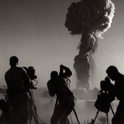After publishing his famous Essay on the Principle of Population in 1798, Thomas Malthus decided it might be a good idea to do some research into the subject. It speaks much for the history of ideas that Malthus's predictions of "gigantic inevitable famine" stalking the inexorably rising population of the world is well remembered, but the same author's more sober later conclusions are forgotten. When Malthus began to examine the record, he was obliged to abandon his thesis: the final 1826 edition of his book can be read as a refutation of the first Essay.
Robert Kaplan is halfway along the same path. His celebrated article in the Atlantic Monthly, (February 1994) "The Coming Anarchy," hit a nerve in the US. Under the subtitle "How scarcity, crime, overpopulation, tribalism and disease are rapidly destroying the social fabric of our planet," the author declared his intention "to remap the political earth the way it will be a few decades hence." He began with Sierra Leone, then in the opening round of a war that could lead only to national disintegration. "It is Malthus, the philosopher of demographic doomsday, who is now the prophet of west Africa's future. And west Africa's future, eventually, will also be that of most of the rest of the world." The apocalyptic counterpoint of Francis Fukuyama's The End of History and The Last Man, Kaplan's description of his travels was of faraway anarchy-a picture at once terrifying and reassuringly familiar.
"The Coming Anarchy" was published three months after the "high tech search, low tech hide" contest in Mogadishu between the US special forces and General Mohamed Farah Aideed ended in humiliation for the former. One reader in the US department of global affairs faxed copies of Kaplan's article to American embassies across the globe; it is widely credited with influencing President Clinton's reluctance to intervene to halt the genocide of the Rwandan Tutsis three months later.
It was a case of verdict and sentence first, evidence later, and the imaginative writer as acknowledged legislator. In The Ends of the Earth we have some more considered evidence. Not enough, and not considered enough, but a beginning.
Kaplan deals with enormous themes. But personal anecdote and lively metaphor stand in place of social inquiry. This is particularly striking in his opening chapters on west Africa. Kaplan takes Richard Burton's side against the eminent Africanist Basil Davidson, who had accused the 19th century adventurer of possessing "the hectoring tone of a man who has travelled much but understood little." There is more than a touch of irony here. Kaplan has now stopped hectoring, but he still makes some astonishing inferences. From his frightened incomprehension of the Liberian rainforest, he concludes that "the myths which might emerge from such a landscape were either too local (connected with tribe) or too general (connected with the earth) to sustain nationhood." From the "terrifyingly vacant" eyes of a young man by the roadside, he moves on to the fact that "there was no economy here, nothing"; and flowing from his "intuition" of the "indefinable wildness" of the place "it occurred to me that, perhaps, the forest had made the war in Liberia." Kaplan's chief literary guides are Joseph Conrad and Graham Greene, and his sole anthropological reference is to tree spirits in Sir James Frazer's Golden Bough-scarcely the best guide to west Africa in the 1990s. Kaplan is smart enough to make some pre-emptive forays against the inevitable accusation of racism-notably he refers to a healthy local teenager as "my genetic superior." He also tries to pre-empt American isolationists with the argument that things in west Africa are so bad that it is becoming our problem as well as theirs. But Kaplan's verdict on west African culture is overwhelmingly negative: he cannot discern one. "I was visiting a failed society." Of the region's young men: "Loose molecules in an unstable social fluid that threatened to ignite."
Some of the urgent doomsaying of "The Coming Anarchy" has gone (the same image was found there, but then the social fluid was "clearly on the verge of igniting"). Perhaps this mellowing is because in the intervening two years there have been serious peace talks in Sierra Leone.
One of the main themes Kaplan takes from west Africa is the "new age primitivism" of warfare: "clearly a pre-modern formlessness governed the battlefield, recalling the wars in tribal or feudal Europe before the Peace of Westphalia introduced the era of organised nation states." His argument is taken from Martin van Creveld's On Future War (1991), which argues for the redundancy of western military establishments in the face of new threats such as terrorism and organised crime. Implicitly, van Creveld counterposed conventional inter-state warfare with anarchy-glossing over the myriad intermediate social formations that can raise armies and wage war, and the fact that the British army, for example, has spent much of the last two centuries as an imperial police force, combating precisely these forms of irregular warfare.
Van Creveld measures himself against Clausewitz, whose project was to show that what his bemused contemporaries called Napoleon's "genius" was instead an eminently replicable formula for military organisation. But van Creveld merely names the cause of western armies' new impotence (crime, terrorism, war for fun); yet these labels are mystifications that do not help us identify who is fighting, why and how. Similarly, Kaplan's use of "anarchy" is merely a label for something that he does not understand.
In his Fighting for the Rainforest: War, Youth and Resources in Sierra Leone (1996), Paul Richards argues that it makes no sense to call west African methods of destruction "barbarism" simply because they are cheap. Much of what appears to be random violence is a deliberate strategy. It is not easy to maintain an army in the field, with arms, fuel and food, in the midst of economic crisis. Hence armies are run in part as commercial ventures, and must ensure that they use limited violence to maximum effect. Conspicuous atrocity is a favoured method: graphic acts of mutilation are magnified in the retelling, spreading fear out of all proportion to the real threat. Rather than surprise, commanders such as the Liberian Charles Taylor prefer to advertise their offensives in advance, promising in one case a "carnival of blood." Combined with the dramatic appearance of his fighters, Taylor ensured that he had won the battle of morale before firing the first shot.
Military intellectuals such as Taylor are ardent students of other wars. He undoubtedly learned from Renamo's use of such methods in Mozambique; Renamo in turn was first trained by the Rhodesians, who learned their counter-insurgency fighting in Malaya in the 1950s. The clandestine cold war schools of destabilisation bear much responsibility for military methods in Africa and the Arab world today.
Richards actually spent some time talking to Kaplan's "loose molecules" and found them unsurprisingly not to be latter day barbarians, but rather frustrated young men who aspired to return to school, to care for the natural environment, and to rebuild their country's roads.
After Sierra Leone, Kaplan's concern with war is more philosophical. He is attracted by the idea of "natural selection" among states and the "clash of civilisations" theory. The fact that the Russians missed the Renaissance due to Turkic invasions has, Kaplan argues, "burned them with feelings of cultural privation and a thirst for revenge" against their southern neighbours. The Armenians, he says, "awoke" from a cultural slumber in the 1980s. Vivid metaphors can illuminate arguments: Kaplan uses them where he has no arguments.
"The Coming Anarchy" stopped in Turkey, where Kaplan found a vibrant patriarchal society with "natural muscle tone." His measure was the cleanliness of slums, and related indices such as a commitment to education and low rates of crime and birth. Over the longue dur?e, he argues, such cultures have what it takes to survive. In an echo of his book Balkan Ghosts (1993) that attributed the Yugoslav wars to ancient enmities, Kaplan describes the "made of stone" identities of the near east, and makes passing mention of the genocide of the Turkish Armenians-putting it nastily in inverted commas. Those who build their arguments by longue dur?e determinism should be judged by it: is such systematic violence a prerequisite to building a "successful" culture? What implications does it hold for contemporary wars? The Ends of the Earth is a jigsaw with too many missing pieces.
Other grand themes-or rather, images, for Kaplan's writing is more panoramic than inductive-pop up throughout. I would like to hear more about the importance of self-created wealth in Thailand, and why prostitution in Bangkok is such a sign of cultural health; also about why wealth inequality is supposedly the best indicator of imminent social explosions. But the most important-at least the most recurrent-issue is the neo-Malthusian scenario of population growth and environmental crisis.
Kaplan typically arrives in a country with his rucksack filled with novels or poetry, 19th century adventurers' memoirs, mythological histories-and projections for population growth. The thesis is refined (a bit) as he progresses. In central Asia he suggests that some cultures are prone to Malthusian crisis, while others are resilient enough to cope. Tropical Africa (except Eritrea), the Uzbeks ("a skid-row version of A Clockwork Orange"), and perhaps Cambodia ("back to Sierra Leone" and war for itself) are "failures." Most Asian societies are not, although Kaplan is pessimistic about Pakistan. Meanwhile Egypt is condemned to hydraulic despotism by its birthrate and dependence on the Nile. Such linking of environmental determinism and cultural essentialism has been the staple of casual Orientalists and Africanists for centuries-it is the dreary fate of specialists to refute such theories, but even as they are demolished they seem to spring up anew.
Spurious statistics fuel much misguided environmental determinism. Kaplan asserts that Sierra Leone's forests have shrunk from 60 per cent of the country's land area at independence in 1960 to 6 per cent today. Richards points out that Sierra Leone was comprehensively logged in the 19th century, with only 3.5 per cent of primary forest standing in 1923. Secondary forest has been growing back since.
Fraudulent figures and powerful images have driven environmental policy and debate in much of the world, often in blatant contradiction to serious research. This has been amply demonstrated for Africa by a recent book edited by Melissa Leach and Robin Mearns, The Lie of the Land: Challenging Received Wisdom on the African Environment (1996). Among other things, this finds that: measured over a generation or more, sand dunes on the southern edge of the Sahara have not moved or grown; in the highlands of central and east Africa, indigenous farming techniques have adapted to four or fivefold increases in population density without encroaching on forests; tree cover is increasing in many thickly settled parts of the savannah.
This is not to deny that there are real ecological problems. Rather, the environmental concern exhibited by international agencies and government departments has become a pretext for entrenching these institutions and extending their scope for intruding into African societies. Often, this intrusion is achieved only by trampling on the interests and ignoring the ecological understanding of African farmers and has done more harm than good. Power is the problem, not culture.
Kaplan should be able to see this: the cases of deforestation he mentions all refer to export-oriented commercial logging. Yet he concludes that irresponsible "slash-and-burn agriculture" is to blame.
The environmental crisis of Azerbaijan and former Soviet central Asia is a calamity on a vaster scale. The draining of the Aral Sea, the excessive use of fertilisers and the oily skies of Baku can scarcely be blamed on overpopulation or failures of indigenous culture; they are a legacy of communist economic planning. This is only a starker version of the conclusion in Africa: state power (or rather, its abuse) determined how many people could live, how well, on a particular piece of land, not the supposed intrinsic capacities of the Uzbek, Azeri or Tajik cultures.
Yet the environmental apocalypse, so vividly portrayed, is left without place in Kaplan's argument, which charges off in a wholly different direction. Struck by the decorative motifs on the dome of the Sheikh Lotfollah mosque in Iran, which "reflected authoritarianism without wisdom or balance," Kaplan asserts that he is witnessing "yet another lesson in the victory of culture over politics."
None the less, in central Asia, Kaplan's certainties are beginning to wear thin: "All I had learned so far was that states in west Africa, the near east and central Asia were weakening, and that ethnic-religious identities appeared stronger by contrast. Beyond that, I had little proof of anything. Travel was indeed frustrating." Thereafter, modesty grows. Crossing from China to Pakistan: "As usual, the truth would turn out to be more complicated that I had supposed." Almost at the end, in Cambodia, Kaplan writes of the "writer's fear of having oversimplified something-in this case, the idea of culture, which now seemed like a greater mystery to me than it had at the beginning of my journey in west Africa."
Indeed so. A literary tourist-cum-war correspondent can do many things, but charting the path of the coming decades is not one of them. But, like Malthus, it is probably Kaplan's fate to be remembered for his wild doomsaying, rather than this final whimper.
The ends of the earth
Robert Kaplan
Papermac 1997, ?10











